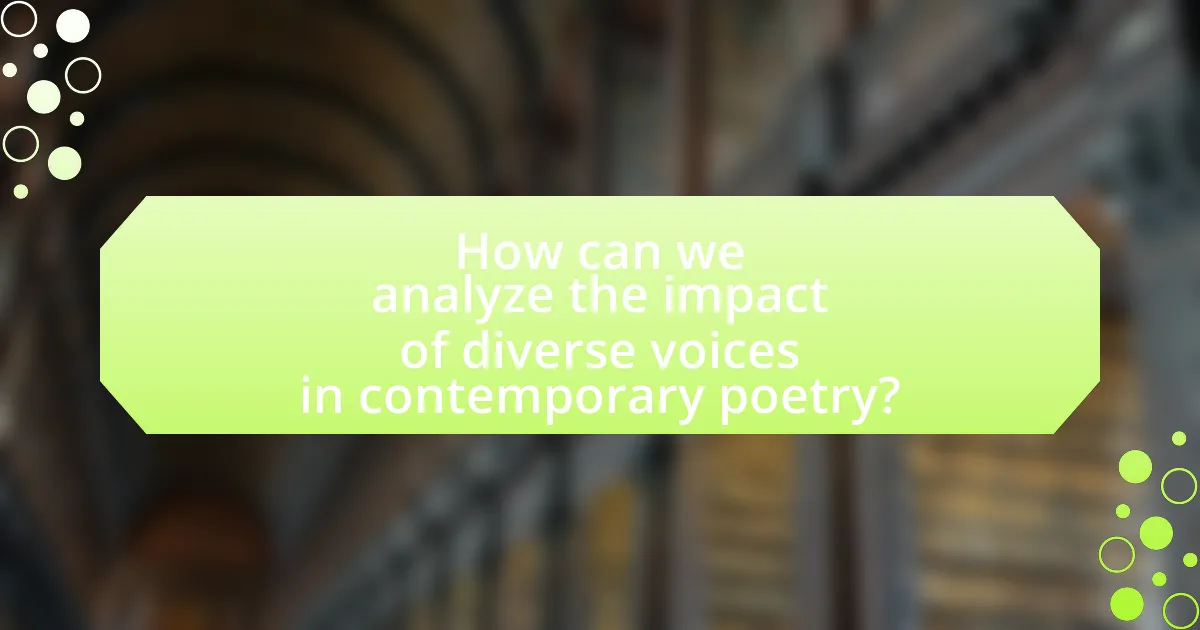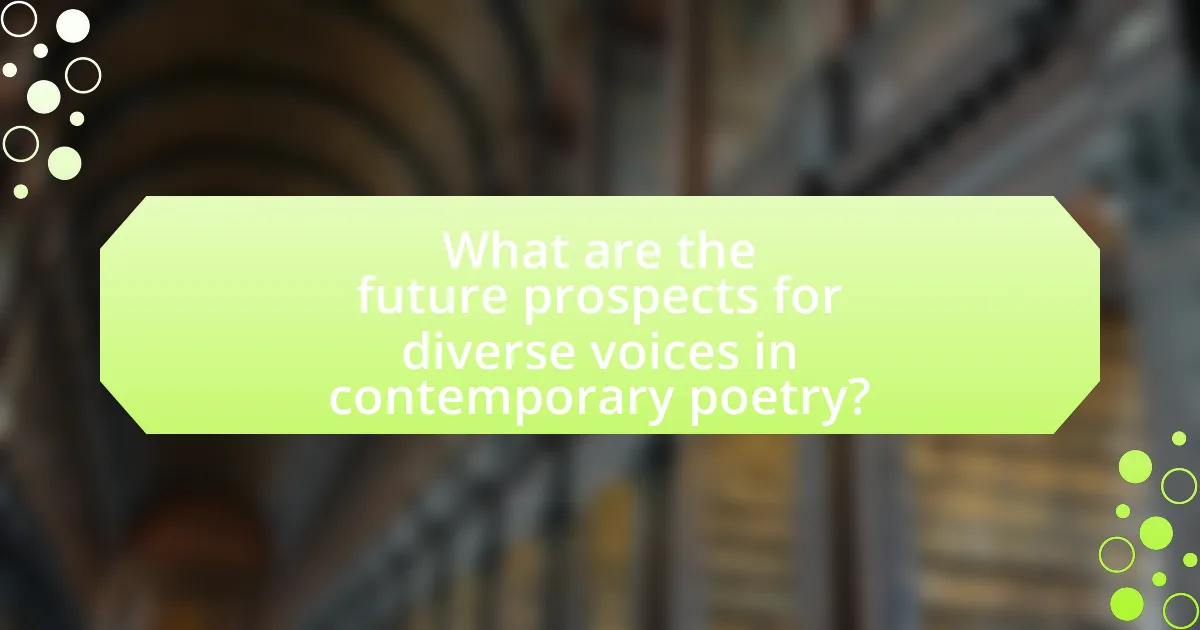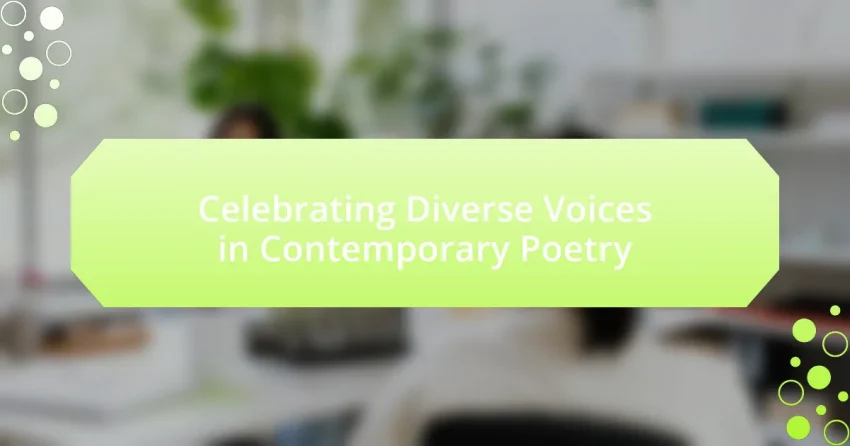Celebrating diverse voices in contemporary poetry involves recognizing and valuing the unique perspectives of poets from various backgrounds, including different cultures, ethnicities, genders, and socioeconomic statuses. This celebration enriches the literary landscape by introducing a multitude of narratives that address themes such as identity, social justice, and cultural heritage. Key contemporary poets like Ocean Vuong, Claudia Rankine, and Amanda Gorman exemplify this diversity, using their work to resonate with broader audiences and challenge traditional poetic norms. The article explores the importance of diversity in poetry, the historical contexts that have shaped these voices, and the platforms that promote inclusivity, ultimately highlighting the impact of diverse narratives on the literary community.

What does it mean to celebrate diverse voices in contemporary poetry?
Celebrating diverse voices in contemporary poetry means recognizing and valuing the unique perspectives and experiences of poets from various backgrounds, including different cultures, ethnicities, genders, and socioeconomic statuses. This celebration enriches the literary landscape by introducing a multitude of narratives and styles, fostering inclusivity and understanding. For instance, the rise of poets like Ocean Vuong and Amanda Gorman highlights how diverse voices can address social issues and personal experiences, resonating with a broader audience. This inclusivity not only reflects the complexity of society but also challenges traditional norms in poetry, making it more accessible and relevant to contemporary readers.
Why is diversity important in contemporary poetry?
Diversity is important in contemporary poetry because it enriches the literary landscape by incorporating a wide range of perspectives and experiences. This inclusion allows for a more comprehensive exploration of themes such as identity, culture, and social justice, reflecting the complexities of modern society. Research indicates that diverse voices in poetry can foster empathy and understanding among readers, as seen in the increased recognition of poets from various backgrounds, such as Ocean Vuong and Claudia Rankine, who address issues of race, sexuality, and belonging. This representation not only validates the experiences of marginalized communities but also challenges dominant narratives, making poetry a powerful tool for social change.
How does diversity enrich poetic expression?
Diversity enriches poetic expression by introducing a multitude of perspectives, experiences, and cultural narratives that enhance the depth and resonance of poetry. This variety allows poets to explore themes such as identity, belonging, and social justice from different angles, fostering a richer dialogue within the art form. For instance, poets from various backgrounds often incorporate unique linguistic styles, cultural references, and emotional truths that reflect their lived experiences, making poetry more relatable and impactful to a broader audience. Research indicates that diverse literary voices contribute to a more inclusive literary landscape, which can lead to increased empathy and understanding among readers, as seen in the works of poets like Ocean Vuong and Claudia Rankine, who draw from their diverse heritages to address universal human experiences.
What are the historical contexts that have shaped diverse voices in poetry?
Historical contexts that have shaped diverse voices in poetry include colonialism, civil rights movements, and globalization. Colonialism imposed cultural hierarchies that marginalized indigenous voices, prompting a literary response that sought to reclaim identity and heritage. For example, post-colonial poets like Derek Walcott and Aime Cesaire articulated the complexities of cultural identity and resistance. Civil rights movements in the 20th century, particularly in the United States, gave rise to voices such as Langston Hughes and Maya Angelou, who used poetry as a tool for social justice and empowerment. Additionally, globalization has facilitated cross-cultural exchanges, allowing poets from various backgrounds to share their experiences and perspectives, as seen in the works of contemporary poets like Ocean Vuong and Warsan Shire. These historical contexts illustrate how poetry has evolved to reflect and amplify diverse voices in response to societal changes.
Who are some key contemporary poets representing diverse voices?
Key contemporary poets representing diverse voices include Ocean Vuong, Claudia Rankine, and Jericho Brown. Ocean Vuong, a Vietnamese-American poet, explores themes of identity, trauma, and love in his acclaimed collection “Night Sky with Exit Wounds,” which won the T.S. Eliot Prize. Claudia Rankine, an African-American poet, addresses race and social justice in her innovative work “Citizen: An American Lyric,” which received the National Book Critics Circle Award. Jericho Brown, also an African-American poet, is known for his collection “The Tradition,” which won the Pulitzer Prize for Poetry and delves into themes of race, sexuality, and personal history. These poets exemplify the rich diversity and complexity of contemporary poetry.
What themes do these poets explore in their work?
Contemporary poets explore themes such as identity, social justice, cultural heritage, and personal experience. These themes reflect the diverse backgrounds and perspectives of the poets, allowing them to address issues like race, gender, and belonging. For instance, poets like Ocean Vuong delve into the complexities of immigrant identity and the impact of trauma, while others, such as Amanda Gorman, focus on themes of hope and resilience in the face of societal challenges. This thematic exploration is evident in their works, which often resonate with readers by highlighting shared human experiences and advocating for change.
How do their backgrounds influence their poetry?
The backgrounds of poets significantly influence their poetry by shaping their themes, perspectives, and stylistic choices. For instance, poets from marginalized communities often draw upon their cultural heritage, personal experiences, and social struggles, which inform their exploration of identity, belonging, and resistance in their work. This is evident in the poetry of writers like Maya Angelou, whose experiences as an African American woman in the United States deeply influenced her themes of resilience and empowerment. Similarly, the immigrant experience is a common theme in the works of poets like Ocean Vuong, whose Vietnamese background informs his exploration of language, memory, and displacement. These specific cultural contexts provide rich material that enhances the emotional depth and authenticity of their poetry, allowing readers to engage with diverse voices and perspectives.
What platforms exist for promoting diverse voices in poetry?
Platforms that promote diverse voices in poetry include social media networks, literary journals, and community organizations. Social media platforms like Instagram and Twitter allow poets to share their work widely and connect with diverse audiences. Literary journals such as The Poetry Foundation and The Offing specifically seek to amplify underrepresented voices, showcasing a variety of cultural perspectives. Additionally, organizations like Cave Canem and Kundiman focus on supporting poets of color through workshops, readings, and mentorship programs. These platforms collectively contribute to a richer, more inclusive literary landscape by providing visibility and resources for diverse poets.
How do literary festivals contribute to this celebration?
Literary festivals contribute to the celebration of diverse voices in contemporary poetry by providing a platform for poets from various backgrounds to share their work and engage with audiences. These festivals often feature readings, panel discussions, and workshops that highlight underrepresented voices, fostering inclusivity and cultural exchange. For example, events like the Brooklyn Book Festival and the London Literature Festival showcase poets from different ethnicities and cultures, promoting a broader understanding of contemporary poetry. This exposure not only elevates diverse perspectives but also encourages dialogue among attendees, enriching the literary community and enhancing appreciation for varied poetic expressions.
What role do social media and online communities play?
Social media and online communities play a crucial role in amplifying diverse voices in contemporary poetry by providing platforms for poets to share their work and connect with audiences globally. These digital spaces facilitate the dissemination of poetry that reflects varied cultural backgrounds, experiences, and perspectives, which might otherwise remain marginalized. For instance, platforms like Instagram and Twitter have enabled poets to reach wider audiences, with hashtags such as #PoetryCommunity fostering engagement and collaboration among writers from different backgrounds. This democratization of poetry allows for a richer, more inclusive literary landscape, as evidenced by the rise of viral poetry trends and the success of poets who gained recognition through social media, such as Rupi Kaur and Amanda Gorman.

How can we analyze the impact of diverse voices in contemporary poetry?
Analyzing the impact of diverse voices in contemporary poetry involves examining how varied cultural, social, and personal perspectives influence themes, styles, and audience reception. Diverse voices enrich the poetic landscape by introducing unique narratives that challenge dominant cultural norms and expand the emotional and intellectual scope of poetry. For instance, poets from marginalized communities often address issues of identity, race, and social justice, which can resonate deeply with readers and foster empathy. Research by the Academy of American Poets indicates that poetry reflecting diverse experiences can lead to increased engagement and understanding among audiences, highlighting the importance of representation in literature.
What metrics can be used to measure this impact?
Metrics that can be used to measure the impact of celebrating diverse voices in contemporary poetry include audience engagement, publication diversity, and critical reception. Audience engagement can be quantified through attendance at poetry readings, social media interactions, and online platform metrics, indicating how well diverse voices resonate with the public. Publication diversity can be assessed by analyzing the representation of various cultural backgrounds in literary journals and anthologies, reflecting the inclusivity of the poetry landscape. Critical reception can be measured through reviews in literary publications and awards recognition, providing insight into how diverse works are valued within the literary community. These metrics collectively offer a comprehensive view of the impact of diverse voices in contemporary poetry.
How do readership and audience engagement reflect this impact?
Readership and audience engagement reflect the impact of celebrating diverse voices in contemporary poetry by demonstrating increased interest and participation in literary discussions. When diverse poets gain visibility, readership metrics such as book sales, social media interactions, and attendance at poetry readings often rise, indicating a broader audience connection. For instance, the success of anthologies featuring diverse voices, like “The BreakBeat Poets,” has shown significant sales figures, illustrating how these works resonate with readers. Additionally, audience engagement through online platforms, such as poetry slams and social media campaigns, fosters community dialogue and encourages the sharing of personal experiences, further amplifying the impact of diverse narratives in poetry.
What are the critical responses to diverse voices in poetry?
Critical responses to diverse voices in poetry often emphasize the importance of representation and the challenge to traditional literary norms. Critics highlight how diverse voices bring unique perspectives that enrich the poetic landscape, fostering inclusivity and challenging dominant narratives. For instance, the rise of poets from marginalized backgrounds has led to a reevaluation of what constitutes poetic merit, as seen in the increased recognition of works by poets such as Ocean Vuong and Claudia Rankine, who address themes of identity, race, and trauma. This shift has been documented in literary critiques and anthologies that prioritize diverse voices, illustrating a broader acceptance and celebration of varied experiences in contemporary poetry.
How do diverse voices challenge traditional poetic forms?
Diverse voices challenge traditional poetic forms by introducing new perspectives, themes, and structures that often defy established conventions. For instance, poets from marginalized communities frequently employ non-linear narratives, colloquial language, and innovative formats that reflect their unique cultural experiences. This shift not only broadens the scope of poetic expression but also critiques the limitations of traditional forms, as seen in the works of poets like Claudia Rankine and Ocean Vuong, who blend prose and poetry to convey complex identities and social issues. Their approaches demonstrate how diverse voices can disrupt the status quo, encouraging a re-evaluation of what poetry can encompass.
What innovative techniques are being used by contemporary poets?
Contemporary poets are employing innovative techniques such as multimedia integration, hybrid forms, and interactive poetry. Multimedia integration involves combining text with visual art, sound, and digital platforms, allowing poets to reach broader audiences and enhance the sensory experience of their work. Hybrid forms blend traditional poetic structures with prose, visual elements, or performance art, creating unique narratives that challenge conventional boundaries. Interactive poetry invites reader participation, often through digital platforms, enabling audiences to engage with the text in dynamic ways. These techniques reflect the evolving landscape of poetry, emphasizing inclusivity and diverse voices.
How do these challenges reshape the understanding of poetry?
Challenges in contemporary poetry, such as cultural appropriation, representation, and accessibility, reshape the understanding of poetry by prompting a reevaluation of whose voices are heard and valued. These challenges encourage poets and readers to critically engage with the historical and social contexts of poetic expression, leading to a broader appreciation of diverse perspectives. For instance, the rise of spoken word and performance poetry has highlighted the importance of oral traditions and marginalized voices, thus expanding the definition of poetry beyond traditional forms. This shift is evidenced by the increasing recognition of poets from various backgrounds in literary awards and anthologies, reflecting a more inclusive understanding of what constitutes significant poetic work.

What are the future prospects for diverse voices in contemporary poetry?
The future prospects for diverse voices in contemporary poetry are promising, as increasing recognition and platforms for underrepresented poets are emerging. Initiatives such as the establishment of literary prizes specifically for diverse authors, like the Lambda Literary Awards, highlight a growing commitment to inclusivity in the literary community. Additionally, the rise of social media and digital publishing has democratized access to audiences, allowing poets from various backgrounds to share their work widely. This trend is supported by data indicating that diverse voices are gaining visibility in major literary publications and festivals, reflecting a shift towards a more inclusive literary landscape.
How can emerging poets continue to diversify the field?
Emerging poets can continue to diversify the field by actively incorporating varied cultural perspectives and experiences into their work. This approach not only enriches the poetic landscape but also reflects the multifaceted nature of contemporary society. For instance, poets from underrepresented backgrounds can draw on their unique narratives, thereby challenging dominant literary norms and expanding the themes explored in poetry. Research indicates that diverse voices in literature lead to greater innovation and creativity, as seen in the rise of movements like spoken word and slam poetry, which often highlight marginalized voices. By participating in workshops, collaborating with poets from different backgrounds, and utilizing platforms that promote inclusivity, emerging poets can further enhance the diversity of the field.
What educational initiatives support diverse voices in poetry?
Educational initiatives that support diverse voices in poetry include programs like the Poetry Foundation’s “Poetry Out Loud,” which encourages students to engage with a wide range of poets from various backgrounds. Additionally, initiatives such as the “Diverse Voices in Literature” program by the National Endowment for the Arts promote the inclusion of underrepresented voices in literary education. These programs provide resources, workshops, and platforms for poets of diverse backgrounds, ensuring that their work is recognized and celebrated.
How can established poets mentor new voices?
Established poets can mentor new voices by providing guidance through workshops, one-on-one feedback sessions, and sharing their experiences in the literary world. These mentorship opportunities allow emerging poets to refine their craft, gain insights into the publishing process, and develop their unique voices. Research indicates that mentorship significantly enhances the confidence and skills of new writers, as evidenced by programs like the Poetry Foundation’s mentorship initiatives, which have successfully paired established poets with emerging talents, fostering a supportive community and promoting diverse voices in contemporary poetry.
What practical steps can readers take to support diverse voices in poetry?
Readers can support diverse voices in poetry by actively seeking out and purchasing works from poets of various backgrounds. This includes exploring anthologies that feature underrepresented voices, attending readings and events that highlight diverse poets, and sharing their work on social media to amplify their reach. Research indicates that diverse representation in literature fosters greater empathy and understanding, making it essential for readers to engage with a wide range of perspectives. By prioritizing these actions, readers contribute to a more inclusive literary landscape.
How can readers engage with and promote diverse poets?
Readers can engage with and promote diverse poets by actively seeking out their work, sharing it on social media, and participating in events that feature these poets. Engaging with diverse poets involves reading their poetry, attending readings or workshops, and discussing their work in literary circles. Promoting can be achieved by amplifying their voices through platforms like Instagram, Twitter, and literary blogs, where sharing quotes or reviews can increase visibility. Research indicates that social media engagement can significantly enhance a poet’s reach; for instance, poets who utilize platforms effectively often see a rise in followers and engagement rates. By supporting diverse poets, readers contribute to a richer literary landscape that reflects a variety of experiences and perspectives.
What resources are available for discovering diverse poetry?
Resources for discovering diverse poetry include online platforms, anthologies, and literary organizations. Websites like Poetry Foundation and Academy of American Poets offer extensive collections of poems from various cultures and backgrounds. Anthologies such as “The Penguin Anthology of Twentieth-Century American Poetry” and “The BreakBeat Poets” showcase a wide range of voices and styles. Additionally, organizations like Cave Canem and Kundiman focus on supporting poets of color, providing workshops and resources that highlight diverse perspectives in poetry. These resources collectively enhance access to a rich tapestry of poetic voices.
